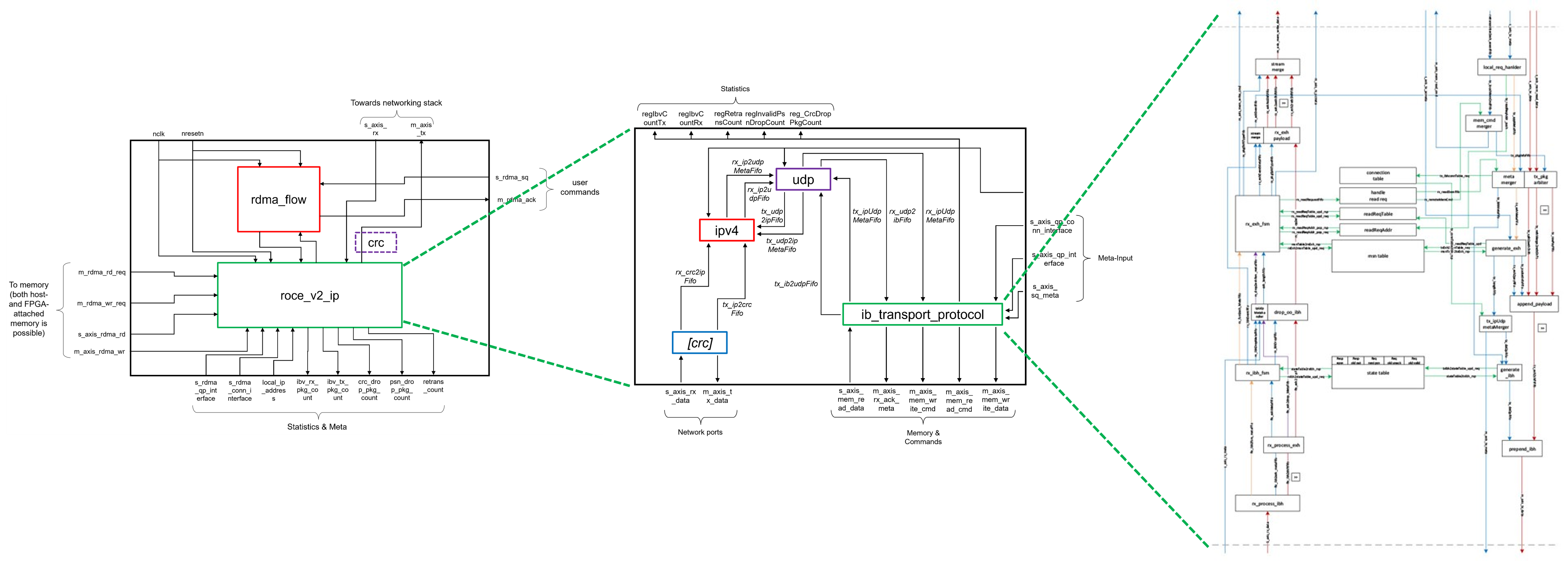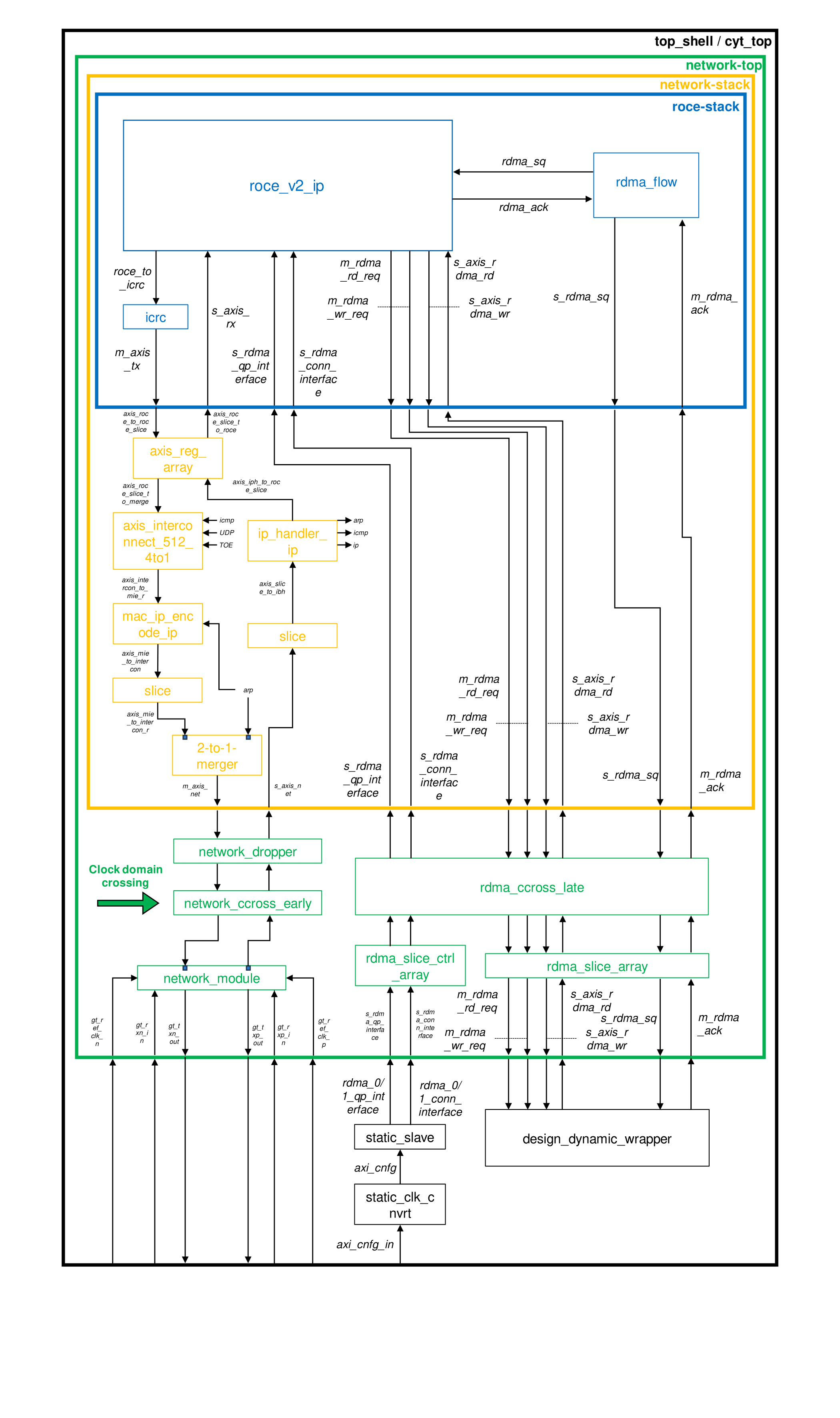Dynamic Layer of the Framework
Architecture
Network Services - TCP/IP
Network Services - RDMA RoCEv2
Coyote comes with a RDMA-stack that is fully compatible to the RoCEv2 networking standard and therefore allows communication with commodity NICs (i.e. tested with Mellanox ConnectX-5 cards.). It is proven to run at 100 Gbit / s in a switched network, allowing for low latency and high throughput comparable to ASIC-based NICs such as the aforementioned.
The architecture of this networking stack is defined in a block diagram as follows:

The packet processing pipeline is coded in Vitis-HLS and included in “roce_v2_ip”, consisting of separate modules for the IPv4-, UDP- and InfiniBand-Headers. In the top-level-module “roce_stack.sv”, this pipeline is then combined with HDL-coded ICRC-calculation and RDMA-flow control.
For actual usage besides pure packet processing, this networking stack is integrated into the Coyote-shell to provide access to memory, host streams and the networking datapath from the CMACs. This system design is depicted as following:

The actual RDMA-logic as discussed in this part is the blue roce_stack. The integration of this part of the design into the rest of the shell is managed via well-defined interfaces:
Network Data Path The two ports s_axis_rx and m_axis_tx are 512-bit AXI4-Stream interfaces and used to transfer network traffic from the shell to the RDMA-stack. With the Ethernet-Header already processed in earlier parts of the networking environment, the RDMA-core expects a leading IP-Header, followed by a UDP- and InfiniBand-Header, payload and a final ICRC-checksum.
Meta Interfaces for Connection Setup RDMA operates on so-called Queue Pairs at remote communication nodes. The initial connection between Queues has to be established out-of-band (i.e. via TCP/IP) by the hosts. To exchanged meta-information then needs to be communicated to the RDMA-stack via the two meta-interfaces s_axis_qp_interface and s_axis_qp_conn_interface. The interface definition in HLS looks like this: .. code-block:: c++
typedef enum {RESET, INIT, READY_RECV, READY_SEND, SQ_ERROR, ERROR} qpState;
- struct qpContext {
qpState newState; ap_uint<24> qp_num; ap_uint<24> remote_psn; ap_uint<24> local_psn; ap_uint<16> r_key; ap_uint<48> virtual_address;
};
- struct ifConnReq {
ap_uint<16> qpn;
ap_uint<24> remote_qpn; ap_uint<128> remote_ip_address; ap_uint<16> remote_udp_port;
};
hls::stream<qpContext>& s_axis_qp_interface, hls::stream<ifConnReq>& s_axis_qp_conn_interface,
Issuing RDMA commands The actual RDMA-operations are handled between the shell and the RDMA-core through the interfaces s_rdma_sq for initiated RDMA-operations and m_rdma_ack to signal automatically generated ACKs from the stack to the shell.
Definition of s_rdma_sq: * 20 Bit rsrvd * 64 Bit message_size * 64 Bit local vaddr * 64 Bit remote vaddr * 4 Bit offs * 24 Bit ssn * 4 Bit cmplt * 4 Bit last * 4 Bit mode * 4 Bit host * 12 Bit qpn * 8 Bit opcode (i.e. RDMA_WRITE, RDMA_READ, RDMA_SEND etc.)
Definition of m_rdma_ack: * 24 Bit ssn * 4 Bit vfid * 8 Bit pid * 4 Bit cmplt * 4 Bit rd
Memory Interface The RDMA stack communicates with the QDMA-core for access to the host memory. Therefore, the memory-control interfaces m_rdma_rd_req and m_rdma_wr_req are designed to hold all information required for communication with this core. The two data interfaces for transportation of memory content m_axis_rdma_wr and s_axis_rdma_rd are 512-Bit AXI4-Stream interfaces.
Definition of m_rdma_rd_req / m_rdma_wr_req: * 4 Bit vfid * 48 Bit vaddr * 4 Bit sync * 4 Bit stream * 8 Bit pid * 28 Bit len * 4 Bit host * 12 Bit dest * 4 Bit ctl
Examples of RDMA WRITE-Flow The following flow chart shows an exemplaric RDMA WRITE-exchange between a remote node with an ASIC-based NIC and a local node with a FPGA-NIC implementing the RDMA-stack. It depicts the FPGA-internal communication between RDMA-stack and shell as well as the network data-exchange between the two nodes:
